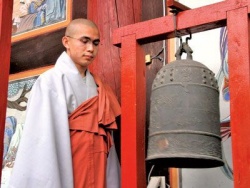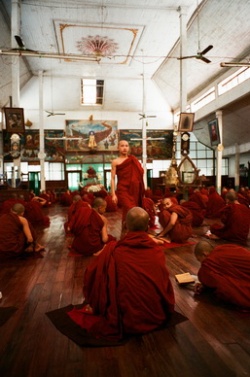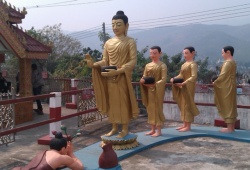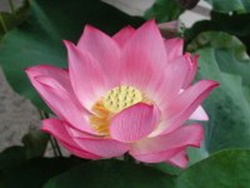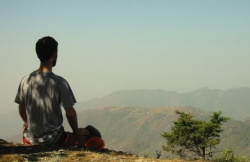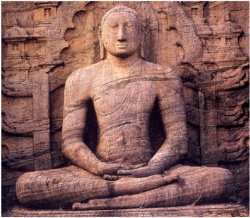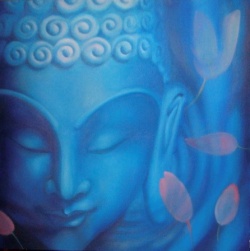Difference between revisions of "Siddha"
(Created page with "thumb|250px| <poem> In the Hindu philosophy of Kashmir Shaivism (Hindu tantra), siddha refers to a Siddha Guru who can by way of Shaktipat initiate dis...") |
|||
| Line 1: | Line 1: | ||
[[File:Koreamonk.jpeg|thumb|250px|]] | [[File:Koreamonk.jpeg|thumb|250px|]] | ||
<poem> | <poem> | ||
| − | In the Hindu philosophy of Kashmir Shaivism (Hindu tantra), siddha refers to a Siddha Guru who can by way of Shaktipat initiate disciples into Yoga. A Siddham in Tamil means "one who is accomplished" and refers to perfected masters who, according to Hindu belief, have transcended the ahamkara (ego or I-maker), have subdued their minds to be subservient to their Awareness, and have transformed their bodies (composed mainly of dense Rajotama gunas) into a different kind of | + | In the Hindu philosophy of Kashmir Shaivism (Hindu tantra), siddha refers to a Siddha [[Guru]] who can by way of Shaktipat initiate disciples into Yoga. A Siddham in Tamil means "one who is accomplished" and refers to perfected masters who, according to Hindu belief, have transcended the ahamkara (ego or I-maker), have subdued their minds to be subservient to their Awareness, and have transformed their bodies (composed mainly of dense Rajotama gunas) into a different kind of [[Body]] dominated by sattva. This is usually accomplished only by persistent meditation. |
| − | According to Jain beliefs, Siddhas are liberated souls who have destroyed all the | + | According to Jain beliefs, Siddhas are liberated souls who have destroyed all the [[Karma]] bondings. Siddha do not have any kind of [[Body]], they are soul at its purest form. They reside in Siddha-shila which is situated at the top of the Universe. |
| − | A siddha has also been defined to refer to one who has attained a | + | A siddha has also been defined to refer to one who has attained a [[Siddhi]]. The [[Siddhis]] as paranormal abilities are considered emergent abilities of an individual that is on the path to siddhahood, and do not define a siddha, who is established in the Pranav or Aum – the spiritual substrate of creation. The [[Siddhi]] in its pure form means "the attainment of flawless identity with Reality ([[Brahman]]); perfection of Spirit." |
Siddha or Siddhar (Tamil tradition) | Siddha or Siddhar (Tamil tradition) | ||
| − | In Tamil Nadu, South India, a siddha (see Siddhar) refers to a being who has achieved a high degree of physical as well as spiritual perfection or | + | In Tamil Nadu, South [[India]], a siddha (see Siddhar) refers to a being who has achieved a high degree of physical as well as spiritual perfection or [[Enlightenment]]. The ultimate demonstration of this is that siddhas allegedly attained physical immortality. Thus siddha, like siddhar or cittar (indigenisation of Sanskrit term in Tamil Nadu) refers to a person who has realised the goal of a type of sadhana and become a perfected being. In Tamil Nadu, South [[India]], where the siddha tradition is still practiced, special individuals are recognized as and called siddhas (or siddhars or cittars) who are on the path to that assumed perfection after they have taken special secret rasayanas to perfect their bodies, in order to be able to sustain prolonged meditation along with a form of pranayama which considerably reduces the number of breaths they take. |
The well known 18 siddhars are listed below. The head of all siddhars is Sri Kagapujandar | The well known 18 siddhars are listed below. The head of all siddhars is Sri Kagapujandar | ||
| Line 32: | Line 32: | ||
Sundarandandar | Sundarandandar | ||
| − | Siddha in Jainism | + | Siddha in [[Jainism]] |
| − | Siddhas are the liberated souls. They have completely ended the cycle of birth and | + | Siddhas are the liberated souls. They have completely ended the cycle of birth and [[Death]]. They have reached the ultimate state of salvation. They do not have any karmas and they do not collect any new karmas. This state of true freedom is called Moksha. They are formless and have no passions and therefore are free from all temptations. |
According to Jains, Siddhas have eight specific characteristics or qualities (8 guñas). Ancient Tamil Jain Classic 'Choodamani Nigandu' describes the eight characteristics in a beautiful poem, which is given below. | According to Jains, Siddhas have eight specific characteristics or qualities (8 guñas). Ancient Tamil Jain Classic 'Choodamani Nigandu' describes the eight characteristics in a beautiful poem, which is given below. | ||
| Line 43: | Line 43: | ||
உடையவன் யாவன் மற்று இவ்வுலகினுக்கு இறைவனாமே" | உடையவன் யாவன் மற்று இவ்வுலகினுக்கு இறைவனாமே" | ||
| − | This means,the soul that has infinite knowledge (Ananta jnāna, கடையிலா ஞானம்), infinite vision or | + | This means,the soul that has infinite knowledge (Ananta jnāna, கடையிலா ஞானம்), infinite vision or [[Wisdom]] (Ananta darshana, கடையிலா காட்சி), infinite [[Power]] (Ananta labdhi, கடையிலா வீரியம்), infinite bliss (Ananta [[Sukha]], கடையிலா இன்பம்), without name (Akshaya sthiti, நாமமின்மை), without association to any [[Caste]] (Being vitā[[Raga]], கோத்திரமின்மை), infinite [[Life]] span (Being [[Arupa]], ஆயுள் இன்மை) and without any change (Aguruladhutaa, அழியா இயல்பு) is [[God]]. |
| − | Thiruvalluvar in his Tamil book Thirukural refer to the eight qualities of God, in one of his couplet poems. | + | Thiruvalluvar in his Tamil book Thirukural refer to the eight qualities of [[God]], in one of his couplet poems. |
Siddhashila | Siddhashila | ||
Siddhashila as per the Jain cosmology | Siddhashila as per the Jain cosmology | ||
| − | In Jain cosmology, siddhashila is situated at the very top of universe. The siddhas (liberated souls who will never take birth again, who have gone above the cycle of | + | In Jain cosmology, siddhashila is situated at the very top of universe. The siddhas (liberated souls who will never take birth again, who have gone above the cycle of [[Life]] and [[Death]]) go to the siddhashila after being liberated and stays there till infinity. Siddha is a level of soul above Arihant who possess kevala jñana. |
| − | In Hindu cosmology, siddhaloka is a subtle world (loka) where perfected beings (siddhas) take birth. They are endowed with the eight primary | + | In Hindu cosmology, siddhaloka is a subtle world (loka) where perfected beings (siddhas) take birth. They are endowed with the eight primary [[Siddhis]] at birth. |
Siddhashrama | Siddhashrama | ||
| − | In Hindu theology, Siddhashrama is a secret land deep in the Himalayas, where great yogis, sadhus and sages who are siddhas live. The concept is similar to Tibetan mystical land of Shambhala. | + | In Hindu theology, Siddhashrama is a secret land deep in the [[Himalayas]], where great yogis, sadhus and sages who are siddhas live. The concept is similar to Tibetan mystical land of [[Shambhala]]. |
Siddhashrama is referred in many Indian epics and Puranas including Ramayana and Mahabharata. In Valmiki's Ramayana it is said that Viswamitra had his hermitage in Siddhashrama, the erstwhile hermitage of Vishnu, when he appeared as the Vamana avatar. He takes Rama and Lakshmana to Siddhashrama to exterminate the rakshasas who are disturbing his religious sacrifices (i.28.1-20). | Siddhashrama is referred in many Indian epics and Puranas including Ramayana and Mahabharata. In Valmiki's Ramayana it is said that Viswamitra had his hermitage in Siddhashrama, the erstwhile hermitage of Vishnu, when he appeared as the Vamana avatar. He takes Rama and Lakshmana to Siddhashrama to exterminate the rakshasas who are disturbing his religious sacrifices (i.28.1-20). | ||
Siddha Sampradaya | Siddha Sampradaya | ||
[[File:Lotus.jpg|thumb|250px|]] | [[File:Lotus.jpg|thumb|250px|]] | ||
| − | Whenever siddha is mentioned the 84 siddhas and 9 nathas are remembered and it is this tradition of siddha which is known as the Siddha Sampradaya. Siddha is a term used for both | + | Whenever siddha is mentioned the 84 siddhas and 9 nathas are remembered and it is this tradition of siddha which is known as the Siddha Sampradaya. Siddha is a term used for both [[Mahasiddhas]] and nathas. So a siddha may mean a siddha, a [[Mahasiddha]] or a natha. The three words siddha, [[Mahasiddha]] and natha are used interchangeably. |
The eighty-four Siddhas in the Varna(na)ratnakara | The eighty-four Siddhas in the Varna(na)ratnakara | ||
| Line 88: | Line 88: | ||
Tongi | Tongi | ||
Mavaha | Mavaha | ||
| − | Nāgārjuna | + | [[Nāgārjuna]] |
Dauli | Dauli | ||
Bhishāla | Bhishāla | ||
| Line 152: | Line 152: | ||
The Siddhas in the Hathayogapradipika | The Siddhas in the Hathayogapradipika | ||
| − | In the first upadeśa (chapter) of the Haṭhayogapradīpikā, a 15th century text, a list of yogis is found, who are described as the Mahasiddhas. This list has a number of names common with those found in the list of the Varna(na)ratnākara: | + | In the first upadeśa (chapter) of the Haṭhayogapradīpikā, a 15th century text, a list of yogis is found, who are described as the [[Mahasiddhas]]. This list has a number of names common with those found in the list of the Varna(na)ratnākara: |
[[File:Meette.jpg|thumb|250px|]] | [[File:Meette.jpg|thumb|250px|]] | ||
Ādinātha | Ādinātha | ||
| Line 170: | Line 170: | ||
Siddhibuddha | Siddhibuddha | ||
Kanthaḍi | Kanthaḍi | ||
| − | + | [[Kora]]ṃṭaka | |
| − | + | Surā[[Nanda]] | |
Siddhapāda | Siddhapāda | ||
| Line 199: | Line 199: | ||
Main article: Siddha Medicine | Main article: Siddha Medicine | ||
| − | Siddha Medicine (" சித்த மருத்துவம் " or " தமிழ் மருத்துவம் " in Tamizh) is one of the oldest medical systems known to mankind. Contemporary Tamizh literature holds that the system of Siddha medicine originated in Southern India, in the state of Tamil Nadu, as part of the trio Indian medicines - ayurveda, siddha and unani. Reported to have surfaced more than 2500 years ago, the Siddha system of medicine is considered one of the most ancient traditional medical systems. | + | Siddha Medicine (" சித்த மருத்துவம் " or " தமிழ் மருத்துவம் " in Tamizh) is one of the oldest medical systems known to mankind. Contemporary Tamizh literature holds that the system of Siddha medicine originated in Southern [[India]], in the state of Tamil Nadu, as part of the trio Indian medicines - ayurveda, siddha and unani. Reported to have surfaced more than 2500 years ago, the Siddha system of medicine is considered one of the most ancient traditional medical systems. |
</poem> | </poem> | ||
{{W}} | {{W}} | ||
[[Category:Buddhist Terms]] | [[Category:Buddhist Terms]] | ||
[[Category:Mahasiddhas]] | [[Category:Mahasiddhas]] | ||
Revision as of 14:21, 24 March 2013
In the Hindu philosophy of Kashmir Shaivism (Hindu tantra), siddha refers to a Siddha Guru who can by way of Shaktipat initiate disciples into Yoga. A Siddham in Tamil means "one who is accomplished" and refers to perfected masters who, according to Hindu belief, have transcended the ahamkara (ego or I-maker), have subdued their minds to be subservient to their Awareness, and have transformed their bodies (composed mainly of dense Rajotama gunas) into a different kind of Body dominated by sattva. This is usually accomplished only by persistent meditation.
According to Jain beliefs, Siddhas are liberated souls who have destroyed all the Karma bondings. Siddha do not have any kind of Body, they are soul at its purest form. They reside in Siddha-shila which is situated at the top of the Universe.
A siddha has also been defined to refer to one who has attained a Siddhi. The Siddhis as paranormal abilities are considered emergent abilities of an individual that is on the path to siddhahood, and do not define a siddha, who is established in the Pranav or Aum – the spiritual substrate of creation. The Siddhi in its pure form means "the attainment of flawless identity with Reality (Brahman); perfection of Spirit."
Siddha or Siddhar (Tamil tradition)
In Tamil Nadu, South India, a siddha (see Siddhar) refers to a being who has achieved a high degree of physical as well as spiritual perfection or Enlightenment. The ultimate demonstration of this is that siddhas allegedly attained physical immortality. Thus siddha, like siddhar or cittar (indigenisation of Sanskrit term in Tamil Nadu) refers to a person who has realised the goal of a type of sadhana and become a perfected being. In Tamil Nadu, South India, where the siddha tradition is still practiced, special individuals are recognized as and called siddhas (or siddhars or cittars) who are on the path to that assumed perfection after they have taken special secret rasayanas to perfect their bodies, in order to be able to sustain prolonged meditation along with a form of pranayama which considerably reduces the number of breaths they take.
The well known 18 siddhars are listed below. The head of all siddhars is Sri Kagapujandar
Patanjali
Agasthyar
Kamalamuni
Thirumoolar
Kuthambai
Korakkar
Thanvandri
Konganar
Sattamuni
Vanmeegar
Ramadevar
Nandeeswarar (Nandidevar)
Edaikkadar
Machamuni
Karuvoorar
Bogar
Pambatti Siddhar
Sundarandandar
Siddha in Jainism
Siddhas are the liberated souls. They have completely ended the cycle of birth and Death. They have reached the ultimate state of salvation. They do not have any karmas and they do not collect any new karmas. This state of true freedom is called Moksha. They are formless and have no passions and therefore are free from all temptations.
According to Jains, Siddhas have eight specific characteristics or qualities (8 guñas). Ancient Tamil Jain Classic 'Choodamani Nigandu' describes the eight characteristics in a beautiful poem, which is given below.
"கடையிலா ஞானத்தோடு காட்சி வீரியமே இன்ப
மிடையுறு நாமமின்மை விதித்த கோத்திரங்களின்மை
அடைவிலா ஆயுஇன்மை அந்தராயங்கள் இன்மை
உடையவன் யாவன் மற்று இவ்வுலகினுக்கு இறைவனாமே"
This means,the soul that has infinite knowledge (Ananta jnāna, கடையிலா ஞானம்), infinite vision or Wisdom (Ananta darshana, கடையிலா காட்சி), infinite Power (Ananta labdhi, கடையிலா வீரியம்), infinite bliss (Ananta Sukha, கடையிலா இன்பம்), without name (Akshaya sthiti, நாமமின்மை), without association to any Caste (Being vitāRaga, கோத்திரமின்மை), infinite Life span (Being Arupa, ஆயுள் இன்மை) and without any change (Aguruladhutaa, அழியா இயல்பு) is God.
Thiruvalluvar in his Tamil book Thirukural refer to the eight qualities of God, in one of his couplet poems.
Siddhashila
Siddhashila as per the Jain cosmology
In Jain cosmology, siddhashila is situated at the very top of universe. The siddhas (liberated souls who will never take birth again, who have gone above the cycle of Life and Death) go to the siddhashila after being liberated and stays there till infinity. Siddha is a level of soul above Arihant who possess kevala jñana.
In Hindu cosmology, siddhaloka is a subtle world (loka) where perfected beings (siddhas) take birth. They are endowed with the eight primary Siddhis at birth.
Siddhashrama
In Hindu theology, Siddhashrama is a secret land deep in the Himalayas, where great yogis, sadhus and sages who are siddhas live. The concept is similar to Tibetan mystical land of Shambhala.
Siddhashrama is referred in many Indian epics and Puranas including Ramayana and Mahabharata. In Valmiki's Ramayana it is said that Viswamitra had his hermitage in Siddhashrama, the erstwhile hermitage of Vishnu, when he appeared as the Vamana avatar. He takes Rama and Lakshmana to Siddhashrama to exterminate the rakshasas who are disturbing his religious sacrifices (i.28.1-20).
Siddha Sampradaya
Whenever siddha is mentioned the 84 siddhas and 9 nathas are remembered and it is this tradition of siddha which is known as the Siddha Sampradaya. Siddha is a term used for both Mahasiddhas and nathas. So a siddha may mean a siddha, a Mahasiddha or a natha. The three words siddha, Mahasiddha and natha are used interchangeably.
The eighty-four Siddhas in the Varna(na)ratnakara
A list of eighty-four siddhas is found in a manuscript (manuscript no 48/34 of the Asiatic Society of Bengal) dated Lakshmana Samvat 388 (1506) of a medieval Maithili work, the Varna(na)ratnākara written by Kaviśekharācārya Jyotirīśvara Ṭhākura, the court poet of King Harisimhadeva of Mithila (reigned 1300–1321). An interesting feature of this list is that the names of the most revered Nathas are incorporated in this list along with the Buddhist Siddhacharyas. The names of the Siddhas found in this list are:
Minanātha
Gorakshanātha
Chauranginātha
Chāmarinātha
Tantipā
Hālipā
Kedāripā
Dhongapā
Dāripā
Virupā
Kapāli
Kamāri
Kānha
Kanakhala
Mekhala
Unmana
Kāndali
Dhovi
Jālandhara
Tongi
Mavaha
Nāgārjuna
Dauli
Bhishāla
Achiti
Champaka
Dhentasa
Bhumbhari
Bākali
Tuji
Charpati
Bhāde
Chāndana
Kāmari
Karavat
Dharmapāpatanga
Bhadra
Pātalibhadra
Palihiha
Bhānu
Mina
Nirdaya
Savara
Sānti
Bhartrihari
Bhishana
Bhati
Gaganapā
Gamāra
Menurā
Kumāri
Jivana
Aghosādhava
Girivara
Siyāri
Nāgavāli
Bibhavat
Sāranga
Vivikadhaja
Magaradhaja
Achita
Bichita
Nechaka
Chātala
Nāchana
Bhilo
Pāhila
Pāsala
Kamalakangāri
Chipila
Govinda
Bhima
Bhairava
Bhadra
Bhamari
Bhurukuti
The Siddhas in the Hathayogapradipika
In the first upadeśa (chapter) of the Haṭhayogapradīpikā, a 15th century text, a list of yogis is found, who are described as the Mahasiddhas. This list has a number of names common with those found in the list of the Varna(na)ratnākara:
Ādinātha
Matsyendra
Śāvara
Ānandabhairava
Chaurangi
Minanātha
Gorakṣanātha
Virupākṣa
Bileśaya
Manthāna
Bhairava
Siddhibuddha
Kanthaḍi
Koraṃṭaka
SurāNanda
Siddhapāda
Charpaṭi
Kānerī
Pūjyapāda
Nityanātha
Nirañjana
Kapālī
Bindunātha
Kākachaṇḍīśvarā
Allāma
Prabhudeva
Ghoḍā
Chholī
Ṭiṃṭiṇi
Bhānukī
Nāradeva
Khaṇḍakāpālika
Siddha Medicine
Main article: Siddha Medicine
Siddha Medicine (" சித்த மருத்துவம் " or " தமிழ் மருத்துவம் " in Tamizh) is one of the oldest medical systems known to mankind. Contemporary Tamizh literature holds that the system of Siddha medicine originated in Southern India, in the state of Tamil Nadu, as part of the trio Indian medicines - ayurveda, siddha and unani. Reported to have surfaced more than 2500 years ago, the Siddha system of medicine is considered one of the most ancient traditional medical systems.
